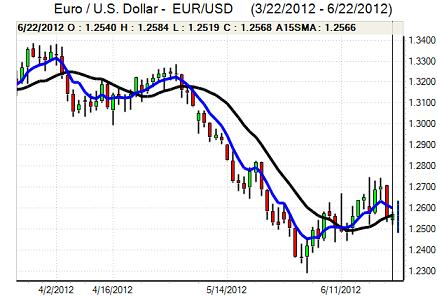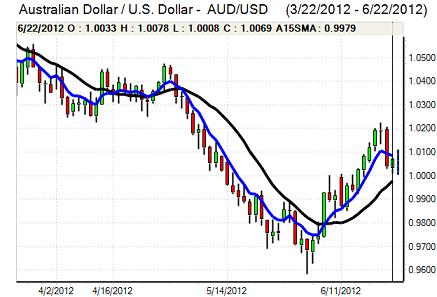EUR/USD
The Euro consolidated in relatively narrow ranges during Friday as support levels towards 1.25 held while the currency was unable to gain any significant momentum. The latest IFO index recorded a decline to 105.3 for June from 106.9 previously as the wider Euro-zone downturn had a greater impact on the German economy. This was the lowest figure for two years, although it did not indicate a severe downturn at this stage.
The ECB confirmed that it had changed collateral rules for banks in order to underpin bank functioning and this did provide an initial Euro boost. The move, however, was strongly criticised by the German Bundesbank and there were wider concerns over the implications for the ECB balance sheet if it accepts weaker collateral in order to help Spanish banks.
German Chancellor Merkel held talks with Italian Prime Minister Monti, French President Hollande and Spanish Prime Minister Rajoy following the latest ECOFIN meeting on Friday. There was a pledge to provide a EUR130bn spending package to boost growth prospects, although there were no details. Merkel and wider German officials continued to deny that Eurobonds were a possibility under current EU law and there was evidence of wider tensions between Germany and France.
Although there was a sharp decline in Spanish bond yields during the day, the Euro failed to derive much benefit. There were major uncertainties ahead of the EU Summit next week, especially with Monti’s warnings that this was the last chance to prevent a Euro break up.
The latest IMM positioning data recorded a significant decline in long US dollar positions and a paring back of short Euro positions, although there were still substantial underlying positions in favour of the US currency.
As the Euro held support around 1.2520 on two occasions and pushed to a high in the 1.2580 area before stalling with a retreat back towards the 1.2530 region in Asia on Monday as the dollar gained some support from stresses in emerging markets.

Source: VantagePoint Intermarket Analysis Software
Call now and you will be provided with FREE recent forecasts
that are up to 86% accurate* 800-732-5407
If you would rather have the recent forecasts sent to you, please go here
Yen
The dollar found support on dips to the 80.25 area against the yen on Friday and challenged the 80.55 area, but was unable to push higher. There was a small increase in US bond yields which provided net US currency support, although the impact was limited.
The US currency initially pushed to highs close to 80.60 in Asia on Monday before retreating back to the 80.15 area as an underlying mood of caution surrounding global growth doubts provided net support for the Japanese currency in an environment of caution surrounding risk and fears that central banks would be unable to provide sustained relief.
Sterling
Sterling hit resistance in the 1.5630 area against the US dollar on Friday and retreated to lows just above 1.5550 as the UK currency remained generally on the defensive. There was a sharp decline in Spanish bond yields during the day with a suspicion that some short-term funds were being pulled back out of Sterling, although this could prove to be only a short-term feature given Euro-zone fears.
There were further expectations that the Bank of England move sanction additional quantitative easing at the next monetary policy meeting which tended to undermine Sterling to some extent as confidence in the economy remained weak.
There were no major UK economic data releases and there will be caution surrounding the Bank of England financial stability report given doubts over the UK banking sector and fears over the Euro-zone impact.
Swiss franc
The dollar hit resistance just above the 0.9580 level against the franc on Friday and retreated back to the 0.9550 region with only measured losses while the Euro remained trapped in the 1.2010 region.
National Bank member Danthine stated that the Euro minimum level was an extraordinary measure, but that it could be in place for a long time given the nature of the crisis. Unless the Euro-zone can stem underlying capital outflows there will continue to be pressure both on the 1.20 minimum Euro level and the National Bank with further intervention and potential wider selling pressure on the Euro as the bank diversifies reserves.

Source: VantagePoint Intermarket Analysis Software
Call now and you will be provided with FREE recent forecasts
that are up to 86% accurate* 800-732-5407
If you would rather have the recent forecasts sent to you, please go here
Australian dollar
The Australian dollar managed to find support just above the parity level against the US currency and moved back to the 1.0060 level during the New York session as markets looked to take a slightly more optimistic tone on risk.
Regional equity markets drifted weaker during the Asian session on Monday which tended to restrain Australian dollar buying support as growth doubts were still an important feature with a drift back towards the 1.0020 area. There were no domestic data releases during the day with markets waiting for further developments surrounding the housing sector.



